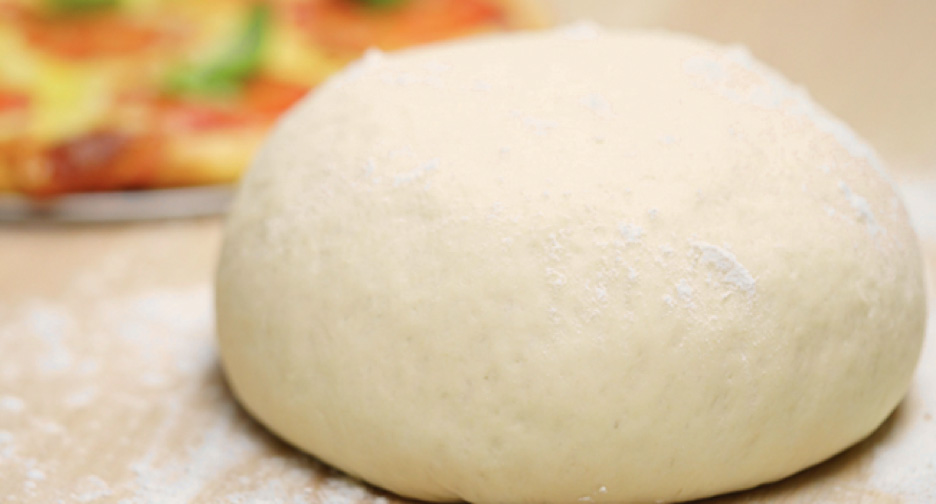INGREDIENTS for 3 lbs (enough for eight 9-inch pizzas):
2 packages (1.2 ounces) fresh yeast OR 2 packages (.5 ounce, 3-1/2 teaspoons) dry-active yeast
2 cups warm water (at body temperature not over 100 F)
7 cups (2 pounds) unbleached all-purpose flour
1 teaspoon salt
1 Preparing the Yeast Starter: Stir the yeast and 1/2 cup of the water in the mixer bowl, blending for several minutes with your fingers to dissolve the yeat completely. Then, still using your fingers, blend in 1 cup of the flour, mixing well to form a smooth batter. Cover the bowl with a towel and set in a warm (about 72 F), draft-free place for half an hour or more, until the starter is full of big bubbles.
2 Mixing and Kneading the Dough: Stir the salt into the remaining flour, mix together well, and add it to the starter. Pour in all but 1/4 cup of the remaining water and attach the bowl to the machine. Start beating at slow speed and gradually increase to medium, adding droplets of water if the dough seems stiff and dry. It is ready when it forms a ball that cleans all the flour from the sides of the bowl. Transfer the dough to a floured counter and knead it several minutes by hand until it is smooth and elastic, and holds its shape when bent back and forth between your two hands.
3 Rising: Briefly knead the dough into a smooth, round ball. Dust the bowl with a sprinkling of flour and flour the ball of dough lightly before turning it about in the bowl. Cut across 3 inches long and 1/2 inch deep in the top of the dough, and sprinkle with a dusting of flour. Cover the bowl with a towel. Let rise to double its volume, again in a warm, draft-free spot (about 72 F) -2 hours or so.
4 Finishing the Dough: Turn the dough out onto a floured counter and knead for 2 minutes. The dough is now ready to use in any way you wish. For pizzas, cut it into 8 pieces, as described in the next step.
5 Ahead-of-Time Note: At this point, the dough may be returned to its bowl, covered with plastic, and left overnight in the refrigerator-punch and weight it down occasionally until it has chilled.
6 Preparing the Pizza Shape: Working on a lightly floured counter and keeping your hands lightly floured so the dough will not stick, cut the dough into 8 even pieces. Work on one piece at a time, leaving the others covered with a towel. Roll a piece in a circular motion under the palm of your hand to form a tennis ball shape, then pick it up in both hands, with your thumbs on top, and gently stretch and fold the dough, always maintaining its round ball shape. Once you start forming the dough, a kind of skin forms on the surface, as though it were very fine rubber-you can’t see it, but you can feel it. By stretching the top surface down to the bottom of the ball and turning and repeating that motion, you create a surface tension that will hold the ball in shape. After 5 to 6 folds and turns, you should have a smooth surface with a rough bottom; now either roll the dough in your hands or rotate it on the counter to smooth the bottom. Repeat with the remaining pieces of dough, setting the balls, smooth side down, on a floured baking sheet. Dust the tops with flour, cover with a towel, and place in a warm (72 to 75 F), draft-free place until they have doubled in volume-about 2 hours.
7 Ahead-of-Time Note: The dough may be kept overnight in the refrigerator, in which case set the balls on an oiled pan, brush the top surface of each ball with olive oil, and cover with plastic wrap, to prevent a crust from forming on the surface. Or you may freeze the balls of dough, wrapping each separately.
Necessary Ingredients for a Natural Foods Pantry
Fava – also known as broad, dates back to ancient Europe. Favas are gaining in popularity for the depth of flavor and silky texture acquire when properly cooked.
Kidney – large l-shaped reddish brown used often in chili and other Southwestern and Mexican recipes, as well as in some Italian dishes. They are mild in flavor.
Lentils – come from the French word meaning “lens”, and they are one of the quickest-cooking and most versatile beans. Used in soups and are the basis of the savory Indian sauce, dahl.
Condiments
With the ever-increasing interest in ethnic foods, there are many more condiments available today.
Some good ones to try are chili paste with garlic, Thai curry pastes, and chipotle peppers in adobo sauce.
Flax seeds – the outstanding source of omega-3 essential fatty acids and soluble fiber. The seeds can be ground and used on cereal. They may also be added whole to baked goods for a nutty crunch as well as a fiber boost.
Quinoa – is usually considered to be a whole grain, but in actuality, it is a seed. However, it can be prepared like whole grains, such as rice or barley.
Flour
Unbleached all-purpose flour – most commonly used flour in baking and cooking.
Whole Wheat Flour – comes in two basic versions: bread flour and pastry flour. Both are high in gluten and ideal for baking.
Grains
Couscous – available in whole wheat or refined wheat versions. Couscous looks like a grain, but it is actually a tiny pasta made from durum (semolina) wheat flour. Traditionally used as a bed for savory Moroccan stews. Because of its ability to absorb and enhance flavors, couscous is liked by natural foods cooks.
Meatless Substitutes
Seitan (wheat gluten) – can be substituted for meat in stews, kebabs, paella, and a host of other dishes.
Well-seasoned, it is the “meatiest” of the meat substitutes.
Tempeh – traditional Indonesian soy food. Its meaty texture and flavor work well in vegetarian burgers, casseroles, and stir-fries.
Nut Butters
Natural nut butter substitute for less healthful spreads and may be used to thicken sauces. Almond butter is a great alternative to peanut butter.
Oils
Canola oil – created in Canada from a special variety of rapeseed. It is an ideal all-purpose oil because it has very little flavor of its own and has a medium-high smoking point.
Olive oil, virgin, and extra-virgin – mainly from Italy, Spain, Greece. Some are more fruity; others spicy or tannic (bitter).
Buy small bottles until you have found the ones you like best. Extra-virgin olive oil comes from the first crushing of the olive fruit and is the finest grade. Try it in homemade vinaigrette dressings, or as a dip for whole-grain bread.
Sesame oil – gives Asian cuisine a distinctive flavor. Refined, it is an excellent choice for stir-frying.
Soy
Soy sauce – do not settle for less than naturally brewed soy sauce, which is also known as shoyu or tamari.
Tamari – traditional Japanese soy sauce made with water, soybeans, and sea salt.
Miso – a versatile seasoning paste made from soybeans. The traditional seasoning of Japanese soup. May also be used in dips and sauces.

